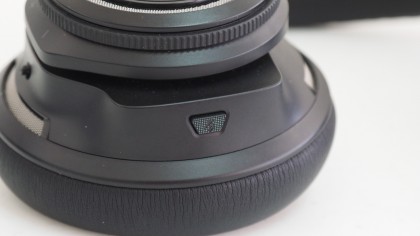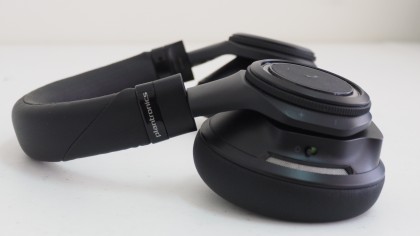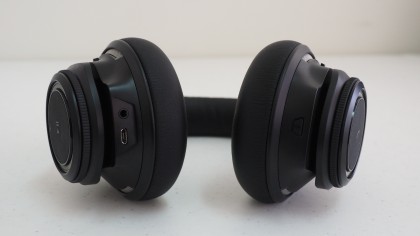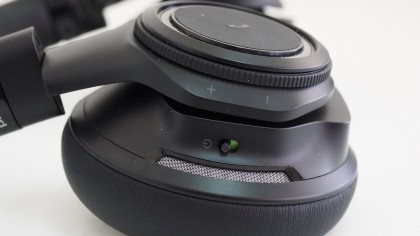Why you can trust TechRadar
Performance
The good news for music fans is that the Backbeat Pro has some very nice audio quality. What's more, they sound great both with and without the noise cancelling features activated.
Overall, the audio is quite well balanced. Bass is solid but not overwhelming, the mids shine through, while the high frequencies get plenty of coverage.
The noise cancellation is also good, especially when partnered with the passive cancellation you get from having the headphones encase your ears.

It can't compete with the active noise cancellation on a pair of Bose headphones, but it's almost a case of the BackBeat Pros having great sound with really good noise cancellation, as opposed to Bose's tendency to have amazing noise cancellation with really good sound.
As you might expect, the Bluetooth integration here is top shelf. Not only do you get a Class 1 radio on the inside, which allows you to listen to music up to a distance of 100 metres from your device, but the BackBeat Pro also allows you to pair two devices simultaneously.
The streaming quality was solid - the connection only really dropped out when we walked a good distance from the source, and even then there were a few walls between the headphones and the device playing music.
Using the headphones for making and receiving phone calls was great, with one of the best quality connections we've found on a Bluetooth pair of headphones.

The dual pairing is incredibly useful too. Pair the BackBeat Pro to your phone and your tablet, and it will seamlessly switch between the two.
You don't even need to do anything to make it work, other than stop what was playing on one device before playing another.
It's not perfect though. For a start, every device you pair with the headphones is referred to as a phone, be it an actual phone, a tablet or a games console.
The little voice that tells you what's going on will announce "phone one connected" or "phone two connected", but that doesn't help you if you're not sure which device is phone one or phone two.

The next challenge is pairing itself. To pop the headphones in pairing mode, you need to hold the answer/call button for two seconds. But there's no audible feedback, and if you press too long, you'll just activate Siri or Google Now.
For Android users, you can get around it with the embedded NFC chip, but iPhone 6 or PS Vita users don't have the luxury.
Still, the convenience still outweighs the challenge in a big way.
Also convenient is the battery life. Plantronics say that it will give you 24 hours of Bluetooth playback with noise cancelling activated.
In real world use, that means that you might – just might – need to recharge the headphones once a week.
Plantronics managed this extraordinary feat by including a couple of sensors that automatically stop music playback when you take the headphones off, saving battery life.
These sensors do occasionally get it wrong – run for the bus and you might find your music stops and starts on every second step, for example – but the music does automatically start playing again when you put them back on.

Bluetooth 4.0 also helps conserve juice, while a deep sleep mode can keep the battery going for up to six months.
If you do run out of battery life, it's a simple matter of plugging in a standard headphone jack, and you can keep listening (albeit without noise cancellation).
And when you go to charge, the Backbeat Pros will go from 0 to 100 per cent battery life in about three hours.
We Liked
There is so, so much to like about these headphones. Audio quality is great, noise cancellation is really good and the controls are super intuitive.
The dual-pairing Bluetooth, 100m range and passthrough button that lets you hear the outside world and your music at the same time all warrant a mention too.
But it's the battery life that makes everything come together. At a time when it's getting harder and harder to go too far from a power point thanks to average battery life, being able to go at least a week between charges is a huge relief.
We disliked
As much as we loved these headphones though, there's still plenty of room for improvement.
For a start, the lack of identification between paired devices is frustrating. Whether it's a voice-to-text upgrade that will identify your device's name or something simpler, it would be nice to have more detail about what's connected.
It would also be nice if there was a bit more feedback when the headphones are put into pairing mode, so it can be easily done without taking them off.
The Backbeat Pros are also a tad heavy. You don't really notice it while wearing them, and it does allow for the integrated battery, but as with most gadgets – lighter is always better.
Final Verdict
At AU$349 / £250 / US$250, these are not a cheap pair of headphones. But they are an investment in both comfort and convenience, and if Bose has taught us anything, it's that those are features people are willing to pay for.
Sure, they're not perfect, but having the ability to pair to multiple devices simultaneously, without having to panic about battery life constantly is an amazingly enticing proposition.
But when it comes down to it, these are some of the most versatile, best performing headphones we've encountered. Given that they are also Plantronics' first foray into the high-end Bluetooth headphone space, it kind of makes us excited to see what the company will do next.
